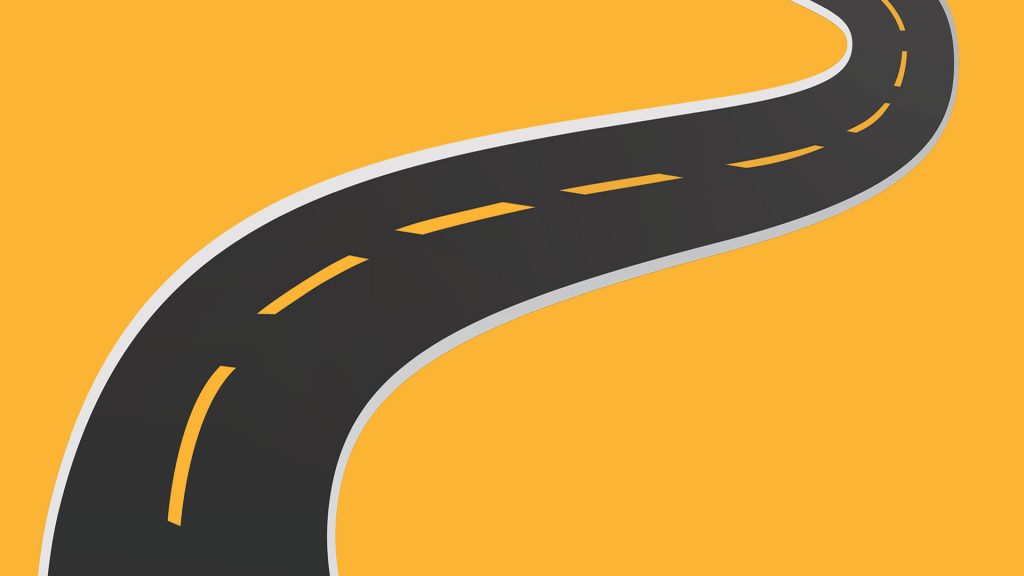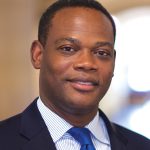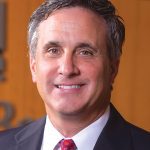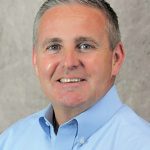The Road Ahead

In late May, after 15 months of living through a global pandemic, the state entered into a phrase the governor called “a new normal.” A few months later, most businesspeople would say this ‘normal’ isn’t everything they expected or wanted. Indeed, while business has picked up in many sectors, from hospitality to healthcare, there are myriad challenges facing the business community, from what can only be called a workforce crisis to shortages of goods and rising prices; from a new and very potent strain of the coronavirus to issues with when and how to bring employees back to the office. To get a sense of where things are and, especially, where we may be headed, BusinessWest convened a panel of area business leaders — Deborah Bitsoli, president of Mercy Medical Center; Harry Dumay, president of Elms College; Patrick Leary, a partner with MP CPAs; Elizabeth Paquette, president of Rock Valley Tool in Easthampton; Tom Senecal, president and CEO of PeoplesBank; and Edison Yee, a principal of the Bean Restaurant Group. Their answers to a series of questions on the economy and the forces shaping it are certainly eye-opening.
BusinessWest: How is the process of returning to ‘normal’ proceeding at your business?
Bitsoli: “It does appear that patients are coming back; our Emergency Department is really returning back to the volumes it had before the pandemic. On the surgical side, the same thing is occurring. I do think there is a lot of caution about the fall, but for the time being, patients are seeking the appropriate level of care, including a lot of the screenings they put off. That’s the good news in terms of a public-health policy standpoint. At the hospital, we’re still wearing masks, and we’re still relying heavily on Webex; we have some meetings face to face, but we still have masks on. As for returning to normal, we continue to have a focus on patient safety, and we have an expansion planned in our Emergency Department. Overall, we are trying to return to normal, but everyone is looking to the fall, and there is caution there. The one big difficulty is hiring staff.”
Dumay: “At the college, ‘normal’ for us would mean getting back to the high-touch, nurturing, vibrant, in-person environment for teaching and learning. Returning to normal means having everyone on campus in the same mode we had pre-pandemic. The process for preparing for that is the same as we had last year, with the ElmsSafe Plan for making sure that employees and students are safe. That begins with a level of vaccination that we need to accomplish. That’s why we came out very early and required vaccinations for our students and employees. The challenges are to ensure that we’re getting to that level of vaccination that the state considers optimal for campuses, which is roughly 90%. We are gearing up for the fall, to have full in-person learning and all of our faculty and staff on campus. We have a task force that is meeting on a regular basis to come up with all the elements of the ElmsSafe plan so that we can make sure our campus is safe and as back to ‘normal’ as possible.”
Harry Dumay
“For the traditional undergraduate, first-time freshman, we had a record deposit year, and we are looking at potentially a record enrollment year for first-time freshmen, so that has come back better than it was before.”
Leary: “We have found that our biggest challenge to returning to normal is a big investment in software. When we all went remote in March of 2020, we found the flaws in our system, we found out where we were falling down and where our system couldn’t handle the stress of people working remotely, etc. So we had a big investment in software across the board — we’ve replaced really all of our systems, so we met the challenge of not only keeping up with workload, but having people keep up with workload while also learning new software. The other challenge involves getting back to the office; being a CPA, we can work from just about anywhere — I can be in my office, or I can be sitting in the Caribbean, which, unfortunately, is not what I’m doing now. This presents us with a lot of challenges. We have a very young workforce — half our staff is 30 or younger — so they’re very much tuned into the social aspects of being in the office and like being in the office, which is great. Our greatest challenge is going to be how we incorporate our client-service work with the protocols of each of our clients; each one presents its own unique circumstances — our staff can’t be stagnant and say ‘this is how we’re going to do things.’
Paquette: “We’re a machine shop that manufactures parts for aerospace, defense, sports, and leisure, blow-mold and extrusion. When everything hit in the spring of 2020, we were getting letters from larger customers saying ‘you can’t shut down — you have to stay working.” So we were very busy, but at the same time, we had seven of our 43 employees leave for one reason or another due to COVID, so we had this intense workload, and we had to scrounge and fill the gaps in our workforce. And then, in mid-June, our largest aerospace customer said, ‘we don’t have anything to send anymore,’ and by the end of the summer, we had laid off a total of 13. Now, with things a little more normalized, we’ve been able to bring back some of those we had to lay off. So when we talk about returning to normal, we’re just trying to work our way through this crisis and keep people’s mental health in mind and … just keep working.”
Senecal: “Overall, I don’t know if ‘normal’ is the right word at this point — it certainly is a new normal. We’re going back to a hybrid method for our workforce — we’re going to allow people to work from home as well as work in our building. I’m a firm believer in culture, and I’m a firm believer in some sort of work in the office. The challenges with that hybrid workforce include dealing with office space — that’s going to affect a lot of our customers — and technology needs; how do we adapt to technology, and how do we use technology? One of the biggest ones is communicating expectations when you go to a hybrid model — how do you communicate with people expectations of what is expected of them, for meetings, for hours worked, for a lot of things? How do you evaluate good performance from a remote-workforce perspective? Those are all a challenge. Also, getting people comfortable with and without facemasks — we’re going back to work in this new normal, and people aren’t sure of the expectations when it comes to facemasks. It’s challenging getting people comfortable in those settings.
Tom Senecal
“I think we’re all going in the right direction, and there’s nothing but good news ahead as long as inflation stays in check.”
Yee: “For restaurants, it’s a new normal as well. Outdoor dining is very much prevalent, but customers are starting to return to the dining rooms. And while they are beginning to feel more comfortable doing so, not everyone has made that transition — although a lot of them have. Our late-night business has not come back yet, but we feel that might change as time progresses. But to be frank, it was a messy way to get into COVID, and coming out of it has been messy as well, with lots of disruption in supply chain, with labor shortages, and other issues. We’re adjusting, as we always do, in the restaurant business, with much more takeout business as part of our overall sales, and with using technology to help us smooth out the rough edges from not having enough frontline workers.”
BusinessWest: How has this year been business-wise, and what is your forecast for the rest of this year?
Bitsoli: “Business is almost back to normal, but it will very interesting to see what happens in the fall when we hit flu season and everyone goes back into the office. And we still have a large number of people who haven’t been vaccinated. Directionally, we’re moving back to normal, but everyone is looking to see what happens when we migrate back inside. Internally, while the volumes of business have returned, people are tired because of the duration of this and the expectation of what’s going to happen in the fall. So we’re investing a lot of resources right now in things like a Zen room, spot yoga, massage chairs … so that is a new normal for us in terms of something we’re going to need to continue on with until we come to the end of this pandemic.”
Dumay: “For the traditional undergraduate, first-time freshman, we had a record deposit year, and we are looking at potentially a record enrollment year for first-time freshmen, so that has come back better than it was before. For continuing-education students, those who come to us from community colleges, that’s a population that often doesn’t enroll until the last minute, so we’re still watching that, but it looks a little softer than it had been previously. And graduate-school enrollment is very much looking to be a record year in terms of enrollment. One area where students and families may still be hesitating is a return to residential living.”
Yee: “For restaurants, we like to compare numbers to 2019, our last ‘normal’ year. And for quarter one, it was lower, when you’re looking at year-over-year numbers. It wasn’t until the vaccinations reached the general population that things started improving; in the second quarter, the sales have bounced back to a much higher level, better than 2019. We anticipate that this trend will continue.
Edison Yee
“We’re very optimistic about the last two quarters of the year and going into 2022. We’ve seen a lot of positive results during this summer, which is traditionally our slower time of year. It’s been a very strong summer to date and much higher than 2019 levels.”
Paquette: “While we had lost work in aerospace, we’ve started to see some of it comes back. For us, workload is good and steady, and we project that this will continue through the rest of the year. The workload is good for the number of people we have.”
Senecal: “In the past 18 months, our deposits are through the roof. We are up more than 35% in a little over a year. And the balances are not going down. As we talk about demand and this influx of demand and a surge in spending, I’m not seeing it from people’s deposit accounts — those numbers are not going down. We’re up over a little more than $1 billion over the past 18 months in deposits. That’s a function of a lot of things — PPP money, stimulus money, people not going out and spending. We have an enormous amount of money in the system, and the government continues to put money into the economy. That adjusts to inflation, and that’s showing up everywhere in our economy — food, transportation, supplies, inventory, computer chips … it’s showing up everywhere, and I think it’s going to have an impact. We see good times ahead as long as inflation can be kept in check and interest rates stay relatively low.”
Leary: “The need for our services greatly increased in 2020 because of the PPP program and other initiatives and trying to help clients understand the rules, what qualifies for forgiveness, and so on. There was great demand for our services, and it’s continued into this year. As for our customers … most of them are doing OK post-pandemic, but I’m concerned that the federal money that these businesses have received is masking how they are doing financially. And as demand starts to grow, will these businesses be able to find the staffing to supply the products and provide the services?
BusinessWest: That’s a good segue to the next question. Attracting and retaining workers has become the dominant challenge for 2021. How has your business been impacted?
Yee: “There is virtually no one applying for jobs, and the people we do have working are tired from working extended hours, so we’re trying to give them breaks by closing an extra day during the week or sometimes two, which we’ve never done in the past. But we’ve found that’s one of the only ways we can deal with this labor shortage — giving people some extra time for that work-life balance.
Senecal: “I received a résumé the other day from a headhunter for a position we were looking to fill … the person was very well-qualified and has all the right skill sets. But in big, bold letters on the résumé, it said this person is only interested in working remotely. I don’t think I’ve ever seen on that on a résumé before, but it’s an indication of the world to come.”
Patrick Leary
“I’m optimistic about the rest of 2021 and 2022, at least the first half. It will be interesting when the government programs start to dry up and slow down and we see how people react to that when it comes to their spending habits.”
Leary: “We’re seeing the same thing many of our customers are seeing. As tax laws change and accounting rules change, we have a great demand for people, and it’s not for entry-level people, but more experienced people. And it’s very challenging to find them. But what we’ve found is that, because of the ability to work remotely, instead of searching for someone and saying, ‘we want you to work in our Springfield office or our Connecticut office,’ we can say, ‘you can work anywhere in the country — we have the ability to let you work wherever you want.’”
Dumay: “I haven’t looked at the comparisons closely, but it certainly seems, anecdotally, that we have more open positions than we normally have. For some, we’re seeing good pools of candidates, and for others, the pools are not as strong as we would like. So in many ways, we’re like everyone else. There is a higher level of vacancy at the college, and for many positions, the pool of applicants is simply not as robust.”
Bitsoli: “From a business standpoint, the thing that’s very different for us and most all businesses is the staffing. It really is different. There are people who retired early, people who decided to change career paths … so we’re dealing with quite a few staffing challenges, like everyone else. One of the things I’ve heard anecdotally is that, because of the incentives being offered by the state, for people at a lower level, like dietary, housekeeping, nurse aides, and other positions, it’s almost better for them financially to stay at home than it is to work. I’ve also heard anecdotally that there’s a group of people that are gathering resilience over the summer, and they plan on coming back after Labor Day.”
BusinessWest: What are the forces — workforce, inflation, inventory, COVID, and more — that will determine where the local economy goes?
Senecal: “I think we’re all going in the right direction, and there’s nothing but good news ahead as long as inflation stays in check. Businesses are opening and growing, and with the levels of demand we’re seeing, that’s a good problem to have. And I think things will start to open up from a supply-chain perspective. We talked a little about unemployment benefits ending in September; let’s see if that pushes people back to work and brings the labor situation closer to normal. Overall, as long as COVID stays under control and we don’t go back to shutdowns — such shutdowns are devastating for the economy — I feel very positive about the fourth quarter and going into 2022.”
Dumay: “I second that optimism and emphasize the ‘as long as’ comment regarding COVID. The only thing that is sobering or bringing caution to my optimism is the slowdown in the rate of vaccination across the country, especially in areas of the country where it’s very low. Also, with the CDC looking at potential mask mandates and people getting alarmed about another surge … that could slow down what is looking to be an optimistic time and an opportunity to really get back to normal.”
Yee: “We’re very optimistic about the last two quarters of the year and going into 2022. We’ve seen a lot of positive results during this summer, which is traditionally our slower time of year. It’s been a very strong summer to date and much higher than 2019 levels. We’re really positive about what’s to come, but there are many challenges that could slow things down moving forward, like labor shortages, inflation, and supply-chain disruptions … those are all major concerns. We’re eager for everyone to get to normal so we can see a higher level of business than we have and, we hope the pent-up demand generates business across the area.”
Bitsoli: “People are looking for optimism, and I think as long as the economy holds out, and if we can get more people vaccinated, things should continue to improve. With the new variants out there are certainly concerns, and there are questions about whether the vaccines are going to continue to keep people healthy even when they’re exposed to the variants and keep them out of the hospitals and from getting severe complications.”
Deborah Bitsoli
“As a leader, what I’ve learned is the importance of that human connection. We’ve all talked about the fact that Webex is great from a technology standpoint, but that relationship building and that ability to look someone in the eye … I really realize that there’s something to that, and it’s quite big.”
Paquette: “It’s really business as usual for us now. Our biggest concern is trying to hire people who are skilled — which means we’re like everyone else. But we’re seeing a lot of people who are interested in growing their skill set, and that, to me, is a positive; I’ve never had as many people enrolled in school and training programs as we do now. We’re rebuilding, we’re in a good space, and we’re growing. It feels much different than a year ago.”
Elizabeth Paquette
“I had to spend a chunk of my time with a remote first-grader, so I had that stress at home while trying to be at work. So I found that employees function better if we’re able to meet them where they’re at.”
Leary: “I’m optimistic about the rest of 2021 and 2022, at least the first half. It will be interesting when the government programs start to dry up and slow down and we see how people react to that when it comes to their spending habits. But as we heard, deposits are way up, which means people have money to spend; they have disposable income. So I think people will start to spend as they get out and feel more comfortable going to restaurants or getting on an airplane. I see that continuing for the next year or so, but who knows after that what will happen? We need to have supplies free up, and we need to push for everyone to get vaccinated.”
BusinessWest: Finally, what have you learned during this pandemic, and how has this made you a different and perhaps better leader?
Bitsoili: “As a leader, what I’ve learned is the importance of that human connection. We’ve all talked about t the fact that Webex is great from a technology standpoint, but that relationship building and that ability to look someone in the eye … I really realize that there’s something to that, and it’s quite big. Also, I knew this before, but now I really know it: you really have to lead from the heart because employees want to feel the empathy and the caring from leadership. Lastly, it’s visibility and the ability to connect with people on their turf and really be able to listen to issues and immediately follow up with resolution. These are all things I knew, but this pandemic has caused me to reflect and overemphasize the need to do those things.”
Dumay: “I realized the importance of connecting with the people with whom I work, the faculty and staff at Elms College, and be present and pay attention to what people are experiencing and have that be relevant to my decision making. Also, I’ve learned the importance of giving people some answers, even if they don’t have the complete answer. There was a lot of uncertainty during the past year, and people were looking for the leaders of organizations to provide some answers. For someone who likes to completely process things and share them when they’re finalized, I had to learn to provide answers that are sometimes incomplete and need to be finalized. That was important to me.”
Leary: “One thing that I learned is that each person is very unique with regard to what their circumstances are — they might be a single parent with high-school children, or they may have a newborn … there are so many factors, and we can’t have a one-size-fits-all policy. We have to be flexible when it comes to work-life balance.”
Paquette: “I had to spend a chunk of my time with a remote first-grader, so I had that stress at home while trying to be at work. So I found that employees function better if we’re able to meet them we’re they’re at. Everything was remote to me outside the shop, but in the shop, it just seemed important that people had someone that they could look to make them feel better. We definitely improved our transparency with employees to let them know where we were at. It was probably so scary to see so many people laid off, some by choice, but some by our choice. I held meetings with people just so they would know what was going on and that they had as much information as I had in that moment. And the response was pretty good. Most people stayed, and they kept at it at a time when it was hard to keep at it.”
George O’Brien can be reached at [email protected]











 Entering a new year, there are always question marks about the economy and speculation about the factors that will determine just what kind of year it will be. For 2021, there are far more questions — and fewer definitive answers — and the speculation comes in layers. A great many of them. Much of this speculation involves the pandemic and, with vaccines becoming available to ever-greater numbers of people, whether we are truly seeing light at the end of the tunnel, the beginning of the end (of the pandemic), or any of those other phrases now being used so frequently. But there are other things to speculate about as well, including what the landscape will look like when and if things to return to normal, or a ‘new normal,’ another phrase one hears a lot these days. Will the jobs that have been lost come back? Will people pick up old habits regarding going to restaurants, the movies, the doctor’s office, or sporting events? Will businesses return to their offices? And will their offices be the same size and in the same community? Another phrase you’re hearing — and will read in the stories that follow — is ‘pent-up demand.’ Many businesses, from eateries to colleges and universities to medical practices, are counting on it, but will it actually materialize? These are all good questions, and for some answers, we turned to a panel of experts for a roundtable discussion, without the roundtable. Collectively, they address the question on everyone’s minds: what is the outlook for 2021?
Entering a new year, there are always question marks about the economy and speculation about the factors that will determine just what kind of year it will be. For 2021, there are far more questions — and fewer definitive answers — and the speculation comes in layers. A great many of them. Much of this speculation involves the pandemic and, with vaccines becoming available to ever-greater numbers of people, whether we are truly seeing light at the end of the tunnel, the beginning of the end (of the pandemic), or any of those other phrases now being used so frequently. But there are other things to speculate about as well, including what the landscape will look like when and if things to return to normal, or a ‘new normal,’ another phrase one hears a lot these days. Will the jobs that have been lost come back? Will people pick up old habits regarding going to restaurants, the movies, the doctor’s office, or sporting events? Will businesses return to their offices? And will their offices be the same size and in the same community? Another phrase you’re hearing — and will read in the stories that follow — is ‘pent-up demand.’ Many businesses, from eateries to colleges and universities to medical practices, are counting on it, but will it actually materialize? These are all good questions, and for some answers, we turned to a panel of experts for a roundtable discussion, without the roundtable. Collectively, they address the question on everyone’s minds: what is the outlook for 2021?
